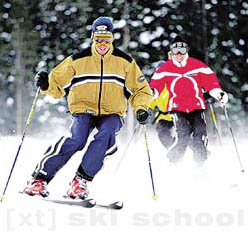|
Beginner Techniques: Overview
Stance is directly related to how fast you will learn the sport of skiing. If you have a narrow base of support, balance will be difficult to maintain, and thereby making the learning process slow and agonizing. The correct stance should be hip width with the feet. Think of the basketball and hockey play, they all have a hip width stance -- it makes for strong balance.
Ankles should be flexed and pushing against the front of the boot cuff. This pressure is what gives you the ability to maneuver the skis. The beginner's mistake in 90% of all lessons is that he reels back from the fear of going to fast, and he loses any ability to turn the skis and slow himself down. Most beginners safety reaction to fear (the shifting of your weight to the heels) becomes a hindrance. The best way to overcome this problem is just to be aggressive and always be driving the shins into the boot cuff.
The knees should be bent slightly. Think of them as shock absorbers. Keep your knees bent and allow movement both up and down. This will give you the ability to absorb any bumps. After all, if you hit a bump and don't absorb it, you'll launch into the air, and in the air, balance is easily lost.
The hips should be centered over the feet, and like the ankles, they always should be more forward than back to facilitate turning. Further, try to keep the hips somewhat facing down the hill when making a turn. Don't let them get twisted into facing up the hill. This will take all the efficiency out of your turns, and it is the number one problem among novice skiers.
The hand position is possibly the most important thing for gaining a forward balanced position. If you keep you hands forward, like holding a tray of food, or even further forward than that, the body will be naturally drawn into the desired position. Further, as with the hips, keep the hands slightly favored toward the downhill side. The rule: hold them out in front and keep them there!
Pole usage and knowing exactly how to use them seems to be a mystery to many students at all levels. At first, the poles are used to push yourself around on the flats. But as you progress, you will rely more and more on the pole for subtle balance adjustments. First, starting with the grip -- get the poles with the straps. The old pistol grip is great for convenience, but ask yourself how many pros do you see with that grip? None. The strap gives you added power when used correctly. The hand goes up through the strap and grabs onto the pole and strap. This way, even if you let go of the pole, the strap will still give you support when you push down.
The shoulders should be held level to the horizon. Don't let them dip or get twisted around. As with the hips, the shoulders should always be facing somewhat down the hill, even when turning. Think of the twist as a separation between the lower and upper body. Even though the legs and skis are going one way, the upper body is always favoring the downhill side. think of the skis as the headlights on your car. As you turn the wheel (your skis), the lights (your shoulders) still face in the direction of travel. As you straighten the wheels of the car out, the headlights realign.
The head should be held much the same as the hips, hands and shoulders -- favoring the downhill side. If you keep yourself looking down the hill, the rest of the upper body will follow.
Alpine Skiing School section in english version of WWW.SKI.BG is based on
"A Guide To Becoming An Expert: From First Time To A Lifetime"
by John Mukavitz Copyright © 1998

|


